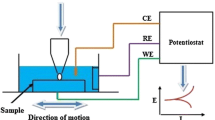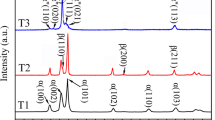Abstract
Titanium alloy is one of the best materials for biomedical applications due to its superior biocompatibility, outstanding corrosion resistance, and low elastic modulus. However, the friction and wear behaviors of titanium alloys were sensitive to the environment including lubrication. In order to clarify the wear mechanism of titanium alloy under different lubrications including deionized water, physiological saline and bovine serum, the friction and wear tests were performed between Ti6Al4V plates and Si3N4 ball on a universal multifunctional tester. The friction and the wear rate of titanium alloy were measured under dry friction and three different lubrication conditions. The worn surfaces were examined by scanning electron microscopy. The results revealed that under the dry friction, the wear resistance of titanium alloy was the worst since the wear mechanism was mainly the combination of abrasive wear and oxidation wear. It was also found that Ti6Al4V alloy had low friction coefficient and wear rate under three lubrication conditions, and its wear mechanism was adhesive wear.
Similar content being viewed by others
References
Masmoudi M, Assoul M, Wery M, Abdelhedi R, El Halouani F, Monteil G. Wear behaviour of nitric acid pas sivated cp Ti and Ti6Al4V. Journal of Alloys and Compounds, 2009, 478, 726–730.
Luo Y, Jiang H, Cheng G, Liu H. Effect of carburization on the mechanical properties of biomedical grade titanium alloys. Journal of Bionic Engineering, 2011, 8, 86–89.
Navaneethakrishnan P, Ganesh Sundara Raman S, Pathak S D, Gnanamoorthy R, Ravi N. Fretting wear studies on diamond-like carbon coated Ti-6Al-4V. Surface & Coatings Technology, 2009, 203, 1205–1212.
Martini C, Ceschini L. A comparative study of the tri-bological behavior of PVD coatings on the Ti-6Al-4V alloy. Tribology International, 2011, 44, 297–308.
Boujelbene M, Dhouibi S, Kharrat M, Dammak M. Analysis of the biotribological behavior for the stainless steel/poly-ethylene contact using a knee prosthesis simulator. Journal of Bionic Engineering, 2012, 9, 59–65.
Wang Q, Zhang L, Dong J. Effects of plasma nitriding on microstructure and tribological properties of CoCrMo alloy implant materials. Journal of Bionic Engineering, 2010, 7, 337–344.
Atar E, Kayali E S, Cimenoglu H. Characteristics and wear performance of borided Ti6Al4V alloy. Surface & Coatings Technology, 2008, 202, 4583–4590.
Molinari A, Straffelini G, Tesi B, Bacci T. Dry sliding wear mechanisms of the Ti6Al4V alloy. Wear, 1997, 208, 105–112.
Güleryüz H, Cimenoğlu H. Effect of thermal oxidation on corrosion and corrosion-wear behaviour of a Ti-6Al-4V al-loy[J]. Biomaterials, 2004, 25, 3325–3333.
Liu X, Chu P K, Ding C. Surface modification of titanium, titanium alloys, and related materials for biomedical applications. Materials Science and Engineering, 2004, 47, 49–121.
Bell J, Besong A A, Tipper J L, Ingham E, Wroblewski B M, Stone M H, Fisher J. Influence of gelatin and bovine serum lubricants on ultra-high molecular weight polyethylene wear debris generated in vitro simulations. Proceedings of the Institution of Mechanical Engineers, Part H: Journal of Engineering in Medicine, 2000, 214, 513–518.
Bell C J, Ingham E, Fisher J. Influence of hyaluronic acid on the time-dependent friction response of articular cartilage under different conditions. Proceedings of the Institution of Mechanical Engineers, Part H: Journal of Engineering in Medicine, 2006, 220, 23–31.
Pickard J, Ingham E, Egan J, Fisher J. Investigation into the effect of proteoglycan molecules on the tribological properties of cartilage joint tissues. Proceedings of the Institution of Mechanical Engineers, Part H: Journal of Engineering in Medicine, 1998, 212, 177–182.
Bell J, Tipper J L, Ingham E, Stone M H, Fisher J. The influence of phospholipid concentration in protein-containing lubricants on the wear of ultra-high molecular weight polyethylene in articial hip joints. Proceedings of the Institution of Mechanical Engineers, Part H: Journal of Engineering in Medicine, 2001, 215, 259–263.
Scholes S C, Unsworth A. The effects of proteins on the friction and lubrication of artificial joints. Proceedings of the Institution of Mechanical Engineers, Part H: Journal of Engineering in Medicine, 2006, 220, 687–693.
Straffelini G, Molinari A. Dry sliding wear of Ti-6Al-4V alloy as influenced by the counterface and sliding conditions. Wear, 1999, 236, 328–338.
Kataria S, Kumar N, Dash S, Tyagi A K. Tribological and deformation behaviour of titanium coating under different sliding contact conditions. Wear, 2010, 269, 797–803.
Luo Y, Ge S. Fretting wear behavior of nitrogen ion implanted titanium alloys in bovine serum lubrication. Tribology International, 2009, 42, 1373–1379.
Yang J, Gu W, Pan L M, Song K, Chen X, Qiu T. Friction and wear properties of in situ (TiB2+TiC)/Ti3SiC2 composites. Wear, 2011, 271, 2940–2946.
Brossia C S, Kelly R G. Occluded solution chemistry control and the role of alloy sulfur on the initiation of crevice corrosion in type 304ss. Corrosion Science, 1998, 40, 1851–1871.
Wu G, Wang C, Zhang W. Tribological property and lubricant mechanism of biomimetic artificial cartilage material. Tribology, 2009, 29, 157–162. (in Chinese)
Author information
Authors and Affiliations
Corresponding author
Rights and permissions
About this article
Cite this article
Luo, Y., Yang, L. & Tian, M. Influence of bio-lubricants on the tribological properties of Ti6Al4V alloy. J Bionic Eng 10, 84–89 (2013). https://doi.org/10.1016/S1672-6529(13)60202-4
Published:
Issue Date:
DOI: https://doi.org/10.1016/S1672-6529(13)60202-4




